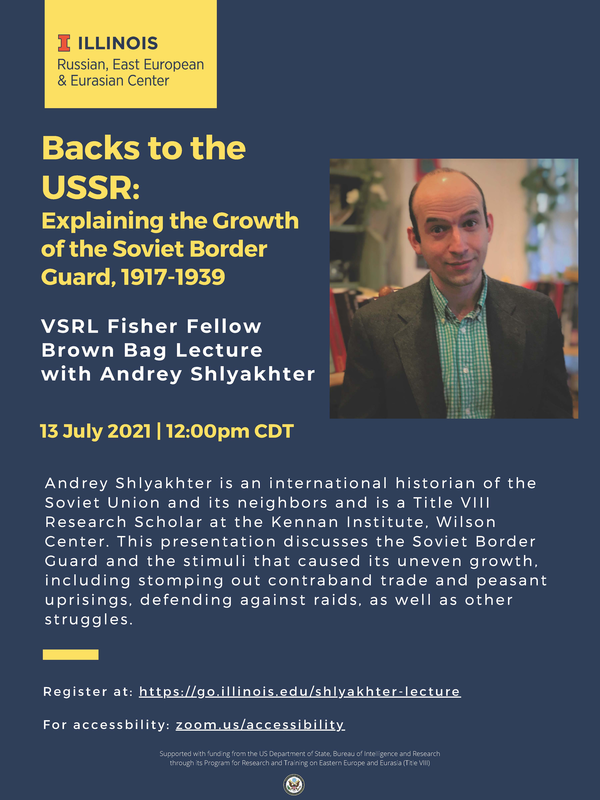
VSRL Fisher Fellow Brown Bag Lecture: Andrey Shlyakhter, "Backs to the USSR: Explaining the Growth of the Soviet Border Guard, 1917-1939"
- Event Type
- Lecture
- Sponsor
- REEEC
- Virtual
- Join online
- Date
- Jul 13, 2021 12:00 pm
- Speaker
- Andrey Shlyakhter (Title VIII Research Scholar at the Kennan Institute, Wilson Center)
- Cost
- Free and open to the public.
- Registration
- Registration
- Contact
- REEEC
- reec@illinois.edu
- Views
- 261
- Originating Calendar
- Russian, E. European & Eurasian Center: Speakers
By the eve of the Second World War, the Soviet Union boasted the world’s most stringent system of border control, successfully established along the world’s longest border. Indeed, the consensus is that "the Soviet Union created one of the most effective border systems in terms of holding its people in that any country had ever constructed.” (Lohr 2012) The pillars of this system were the border guards, responsible for “guarding the Soviet borders from their own citizens.” (Felshtinsky 1991) It is difficult to imagine Stalinism taking hold without a secured frontier to forestall flight; and indeed, between the establishment of the Soviet state and its westward expansion in 1939, the number of Soviet border guards grew nearly fivefold.
However, despite pioneering studies of Soviet border control (Chandler 1998; Dullin 2014), no scholar has systematically analyzed the growth of the Soviet border guard. Drawing on archival research in Russia and Eastern Europe, this presentation demonstrates that, rather than an inexorable increase in pursuit of imprisoning the Soviet population, the growth of the Soviet border guard proceeded unevenly in time and space, in response to a variety of challenges. These included the struggle against contraband trade; defending against guerilla incursions and brigand raids; suppressing peasant and nomad uprisings; securing border area military installations; and sealing the frontier from real and imagined spies and saboteurs.
To be sure, the growth of the Soviet border guard, alongside a host of other border security and population control measures, made escape increasingly difficult if not impossible; but while “holding its people in” became the border guard’s most salient function, the archival record reveals that this was not the regime’s chief motivation for the creation and growth of the border guard apparatus. Given the paradigmatic significance of the Soviet model of population isolation and its postwar export to Eastern Europe and East Asia, this reassessment of the foundation of the Soviet border guard forces a reconsideration of the machinery of border control in the modern world. Just as the late 20th and early 21st centuries’ “wars” on drugs and terrorism led states to cultivate border policing capacity later deployed against migrants and refugees, so too did Soviet efforts to neutralize a host of real and imagined threats by growing the border guard help seal the Soviet population behind an Iron Curtain.
This presentation is based on an article in preparation for a special issue of International Migration, titled “Exit Regulation: How States Govern Departure Abroad,” edited by Matthew Light (University of Toronto) and Willem Maas (York University).
Andrey Shlyakhter is an international historian of the Soviet Union and its neighbors. His research explores the interaction of economics, security, and ideology at state frontiers. Dr. Shlyakhter received his PhD from the University of Chicago Department of History in December 2020, with the dissertation “Smuggler States: Poland, Latvia, Estonia, and Contraband Trade Across the Soviet Frontier, 1919-1924,” which has won the Ab Imperio Annual Award “for the best study in new imperial history and history of diversity in Northern Eurasia, up to the late twentieth century, published in 2020” in the “Best Dissertation Chapter” category. The dissertation informs his postdoctoral book project, Smuggling Across the Soviet Borders: Contraband Trades, Soviet Solutions, and the Shadow Economic Origins of the Iron Curtain, 1917-1932. Dr. Shlyakhter is a Title VIII Research Scholar at the Kennan Institute of the Woodrow Wilson International Center for Scholars in Washington, D.C, and the 2021 Fisher Fellow at the Virtual Summer Research Laboratory. This fall, he will join the YIVO Institute for Jewish Research as a Dina Abramowicz Emerging Scholar Fellow in Eastern European Jewish Studies. Previously, he served as Director of Education at Hermiona Education, a social enterprise that prepares students across the former USSR for rigorous academic programs in the United States.